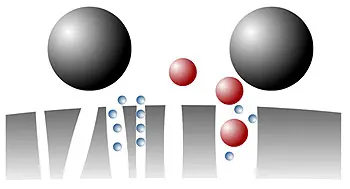Stationary phases in GFC/SEC
The stationary phases in gel filtration chromatography are either porous silica or polymer-based materials such as polyhydroxymethacrylate or polyvinyl alcohol. In order to reduce adsorption or other undesirable interactions of the analytes with the silica materials, these are usually functionalised with diol groups or undergo special treatment during the manufacturing process. Silica phases are used as stationary phases, especially for proteins, antibodies and enzymes, as they have a high resolution and recovery rate. Polymer-based materials are increasingly being used for other polar polymers such as polyethylene glycol.
Mobile phases of the GFC/SEC
Water is mainly used as the mobile phase for gel filtration chromatography (GFC). GFC is used as a bioseparation technique for the separation of proteins and other large biomolecules and therefore the use of buffers or salts can be helpful. In addition to aqueous eluents, mixtures of water and organic solvents such as acetonitrile and methanol can also be used in some cases.
Detectors of the GFC/SEC
Basically, the same detectors can be used for gel filtration chromatography as in HPLC. UV and RI detectors are used particularly frequently. In addition, light scattering and viscosity detectors are also used for polymer analysis in order to obtain specific molecular and structural information about the analyte. When SEC is combined with light scattering, viscometers and concentration detectors (known as triple detection), it can calculate absolute molecular weight, molecular size and intrinsic viscosity, as well as provide information on macromolecular structure, conformation, aggregation and branching. To obtain absolute molecular weights of a sample, the Multi Angle Light Scattering Detector (MALS) can be used. This detector works in a similar way to the simple light scattering detector.
Reference materials for GFC/SEC
By using reference materials with known molecular size and molecular mass distribution, the GFC system can be calibrated to allow precise analysis of molecular weights and molecular size distribution in a sample. Calibration standards are essential to regularly check the performance of the GFC system and ensure that results are consistent and reliable over time. These standards also help to optimise separation conditions and improve analytical accuracy, making them a critical component of high quality GFC analysis. MZ-Analysentechnhik GmbH offers you a wide range of different SEC reference materials from manufacturers such as Sigma Aldrich, Tosoh, Shodex or Waters.
